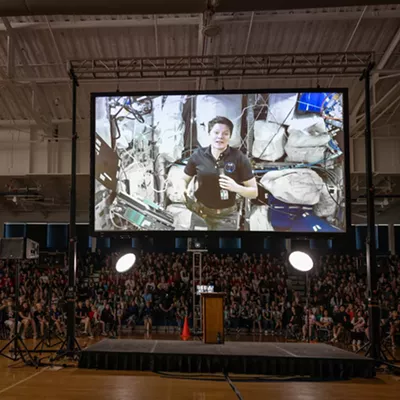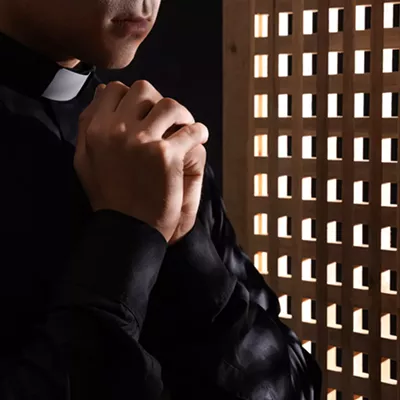Inside the shop, Mountain Goat owner Lon McRae espouses the importance of a whitewater park -- even though he has never visited one and only began whitewater kayaking last year. "It's something people would actually move here for," McRae predicts of the downtown park, slated for construction next year. It's estimated to cost approximately $1 million; the Washington legislature appropriated $530,000 for it this year.
For now, the park resides in the hearts and minds of its local supporters. Whitewater parks exist elsewhere too, including Golden, Colo., Reno, Nev. and Missoula, Mont. And Missoula's "Brennan's Wave" has "been a great thing" for the city, according to Missoula Parks and Recreation Director Donna Gaukler. "They do kayaking year round, as long as there isn't any ice," she says with a laugh.
But the economic impact the park has had on Missoula is hardly a laughing matter. According to Gaukler, its success has prompted downtown businesses and hotels to advertise the park to potential tourists.
& lt;span class= "dropcap " & S & lt;/span & teve Faust is a middle-aged lawyer, an avid outdoorsman. He is also the president of Friends of the Falls, the local nonprofit group that has long promoted the whitewater park, as well as worked to protect and improve access to the Spokane Falls and river gorge.
"Quite frankly, I think we've got a nicer site than Missoula," Faust begins. "In Missoula you can't really escape the fact you're in a city."
Though the site of the whitewater park is just a mile west of Spokane's downtown, by the Sandifur Bridge, Faust suggests Spokane's site is more secluded, even more intimate than Missoula's. The site and the expected quality of the park both factor into Faust's overarching goal: to lure people to Spokane.
"Our interest in this project has to do with a bigger vision," Faust says. His aim is to attract people to not only kayak, but to canoe, swim, sunbathe and just watch. "We still think there's a great opportunity for the downtown and this area."
The high hopes Faust harbors for the park are outlined in its conceptual design, downloadable from the Friends of the Falls Website (friendsofthefalls.org). The park is nestled between two sloping banks approximately three feet from the water. Recreational Engineering and Planning, the firm responsible for constructing the whitewater park, identified another site near Glover Park as a potential home to the park.
"But our feeling was that the site next to Glover Park was too close to the Peaceful Valley neighborhood," Faust explains.
Large concrete pillars in the park's proposed footprint pose a menacing obstacle for future whitewater park users. But Faust has already thought of that, too.
"All of those bridge pillars are going to come out," he says.
Despite the pillars, the Sandifur Bridge area was more appealing because of the bridge connecting both banks, the accessibility from the downtown area and potential for spectator interaction. That interaction, according to Faust, is crucial to the success of a whitewater park. He estimates that for every boat in the water, 10 more people will visit the park. And due to the size of the river, Faust anticipates six or seven boaters will be able to use the park at once.
Because of the size of the whitewater-park area and the variety of other outdoor sports available in Spokane, Faust says he wouldn't be surprised if Spokane started an annual festival with the whitewater park as its focal point, similar to the Teva Mountain Games, held annually in Vail, Colo. According to its Website, the Games are "the country's largest celebration of mountain sport" and related outdoor activities. Professional and amateur athletes compete in six sports and ten disciplines, including various forms of kayaking.
& lt;span class= "dropcap " & F & lt;/span & aust describes Spokane's whitewater recreational area as "a park-and-play type of facility," a park where ease of entry is important. Users will park their vehicles in the existing parking lot near the Sandifur Bridge, walk to the river on a new gravel pathway and play in areas where U-shaped structures enhance the waves that boaters will navigate.
"Literally, you could see a school bus full of kids coming to kayak," Faust envisions. "With everyone signing an appropriate waiver," he adds with a grin.
Terry Miller, president of Spokane Canoe and Kayak Club, views boating education -- especially for novice boaters -- as the cornerstone of the park. "It will be a great teaching tool," he says.
And while education is an important component of the park, so too is environmental awareness. Miller and Lon McRae both characterize the kayaking and canoeing community as concerned with the well being of the outdoors. Both predicted the park would lead to environmental and aesthetic improvements to the Sandifur Bridge area.
"There will be some ownership," McRae says, adding he suspects local kayakers will organize an annual river cleanup.
But before the school buses arrive and the river cleanups occur, a few hurdles remain for the park. The project must obtain various building permits to prevent damage to the river during construction. "It will be a long process," Faust predicts, perhaps as long as a year. The window is not unusual for whitewater parks, he says.
Once the permits are processed, the construction of the park will begin next summer when the water is low and more manageable.
Until then, the yellow kayak will have to wait at Mountain Goat, serving as a reminder to the whitewater community of what is in store.
And as soon as the park is complete? The kayak will return to its natural habitat: the river.
















